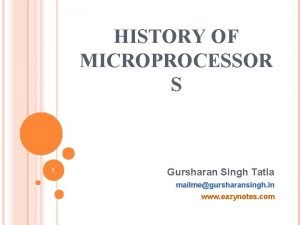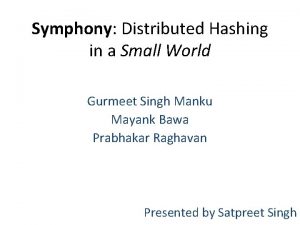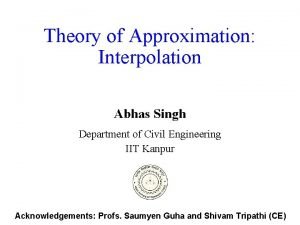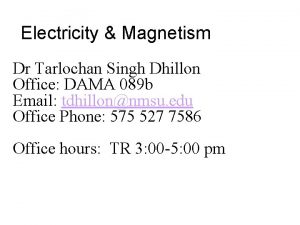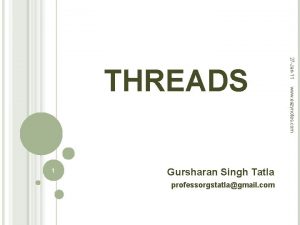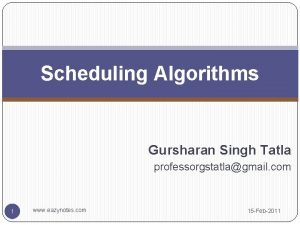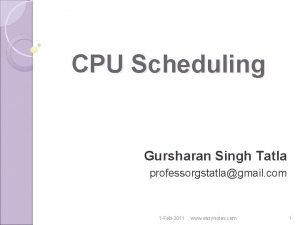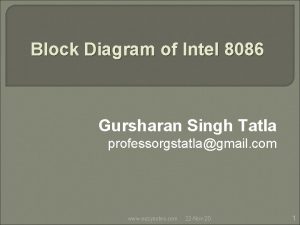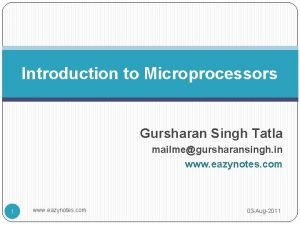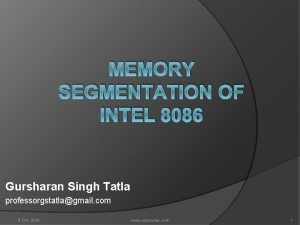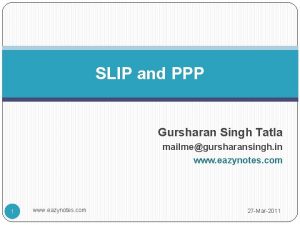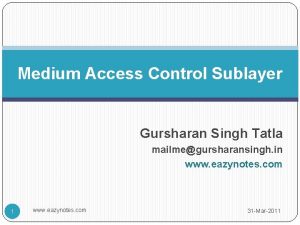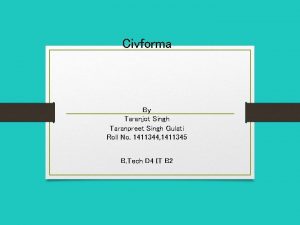Gursharan Singh Tatla professorgstatlagmail com Gursharan Singh Tatla


































- Slides: 34

Gursharan Singh Tatla professorgstatla@gmail. com Gursharan Singh Tatla www. eazynotes. com 1

Intel 8086 was launched in 1978. It was the first 16 -bit microprocessor. This microprocessor had major improvement over the execution speed of 8085. It is available as 40 -pin Dual-Inline-Package (DIP). Gursharan Singh Tatla www. eazynotes. com 2

Intel 8086 It is available in three versions: 8086 (5 MHz) 8086 -2 (8 MHz) 8086 -1 (10 MHz) It consists of 29, 000 transistors. Gursharan Singh Tatla www. eazynotes. com 3

Intel 8086 It has a 16 line data bus. And bus. 20 line address It could address up to 1 MB of memory. It has more than 20, 000 instructions. It supports multiplication and division. Gursharan Singh Tatla www. eazynotes. com 4

Pin Diagram of Intel 8086 Gursharan Singh Tatla www. eazynotes. com 5

AD 0 – AD 15 Pin 16 -2, 39 (Bi-directional) These lines are multiplexed bidirectional address/data bus. During T 1, they carry lower order 16 -bit address. In the remaining clock cycles, they carry 16 -bit data. AD 0 -AD 7 of data. carry lower order byte AD 8 -AD 15 carry higher order byte of data. Gursharan Singh Tatla www. eazynotes. com 6

A 19/S 6, A 18/S 5, A 17/S 4, A 16/S 3 Pin 35 -38 (Unidirectional) These lines are multiplexed unidirectional address and status bus. During T 1, they carry higher order 4 -bit address. In the remaining clock cycles, they carry status signals. Gursharan Singh Tatla www. eazynotes. com 7

BHE / S 7 Pin 34 (Output) BHE stands for Bus High Enable. BHE signal is used to indicate the transfer of data over higher order data bus (D 8 – D 15). 8 -bit I/O devices use this signal. It is multiplexed with status pin S 7. Gursharan Singh Tatla www. eazynotes. com 8

RD (Read) Pin 32 (Output) It is a read signal used for read operation. It is an output signal. It is an active low signal. Gursharan Singh Tatla www. eazynotes. com 9

READY Pin 22 (Input) This is an acknowledgement signal from slower I/O devices or memory. It is an active high signal. When high, it indicates that the device is ready to transfer data. When low, then microprocessor is in wait state. Gursharan Singh Tatla www. eazynotes. com 10

RESET Pin 21 (Input) It is a system reset. It is an active high signal. When high, microprocessor enters into reset state and terminates the current activity. It must be active for at least four clock cycles to reset the microprocessor. Gursharan Singh Tatla www. eazynotes. com 11

INTR Pin 18 (Input) It is an interrupt request signal. It is active high. It is level triggered. Gursharan Singh Tatla www. eazynotes. com 12

NMI Pin 17 (Input) It is a non-maskable interrupt signal. It is an active high. It is an edge triggered interrupt. Gursharan Singh Tatla www. eazynotes. com 13

TEST Pin 23 (Input) It is used to test the status of math co-processor 8087. The BUSY pin of 8087 is connected to this pin of 8086. If low, execution continues else microprocessor is in wait state. Gursharan Singh Tatla www. eazynotes. com 14

CLK Pin 19 (Input) This clock input provides the basic timing for processor operation. It is symmetric square wave with 33% duty cycle. The range of frequency of different versions is 5 MHz, 8 MHz and 10 MHz. Gursharan Singh Tatla www. eazynotes. com 15

VCC and VSS Pin 40 and Pin 20 (Input) VCC is power supply signal. +5 V DC is supplied through this pin. VSS is ground signal. Gursharan Singh Tatla www. eazynotes. com 16

MN / MX Pin 33 (Input) 8086 works in two modes: Minimum Mode Maximum Mode If MN/MX is high, it works in minimum mode. If MN/MX is low, it works in maximum mode. Gursharan Singh Tatla www. eazynotes. com 17

MN / MX Pin 33 (Input) Pins 24 to 31 issue two different sets of signals. One set of signals is issued when CPU operates in minimum mode. Other set of signals is issued when CPU operates in maximum mode. Gursharan Singh Tatla www. eazynotes. com 18

Pin Description for Minimum Mode Gursharan Singh Tatla www. eazynotes. com 19

INTA Pin 24 (Output) This is an interrupt acknowledge signal. When microprocessor receives INTR signal, it acknowledges the interrupt by generating this signal. It is an active low signal. Gursharan Singh Tatla www. eazynotes. com 20

ALE Pin 25 (Output) This is an Address Latch Enable signal. It indicates that valid address is available on bus AD 0 – AD 15. It is an active high signal and remains high during T 1 state. It is connected to enable pin of latch 8282. Gursharan Singh Tatla www. eazynotes. com 21

DEN Pin 26 (Output) This is a Data Enable signal. This signal is used to enable the transceiver 8286. Transceiver is used to separate the data from the address/data bus. It is an active low signal. Gursharan Singh Tatla www. eazynotes. com 22

DT / R Pin 27 (Output) This is a Data Transmit/Receive signal. It decides the direction of data flow through the transceiver. When it is high, data is transmitted out. When it is low, data is received in. Gursharan Singh Tatla www. eazynotes. com 23

M / IO Pin 28 (Output) This signal is issued by the microprocessor to distinguish memory access from I/O access. When it is high, memory is accessed. When it is low, I/O devices are accessed. Gursharan Singh Tatla www. eazynotes. com 24

WR Pin 29 (Output) It is a Write signal. It is used to write data in memory or output device depending on the status of M/IO signal. It is an active low signal. Gursharan Singh Tatla www. eazynotes. com 25

HLDA Pin 30 (Output) It is a Hold Acknowledge signal. It is issued after receiving the HOLD signal. It is an active high signal. Gursharan Singh Tatla www. eazynotes. com 26

HOLD Pin 31 (Input) When DMA controller needs to use address/data bus, it sends a request to the CPU through this pin. It is an active high signal. When microprocessor receives HOLD signal, it issues HLDA signal to the DMA controller. Gursharan Singh Tatla www. eazynotes. com 27

Pin Description for Maximum Mode Gursharan Singh Tatla www. eazynotes. com 28

QS 1 and QS 0 Pin 24 and 25 (Output) These pins provide the status of instruction queue. QS 1 QS 0 Status 0 0 No operation 0 1 1 st byte of opcode from queue 1 0 Empty queue 1 1 Subsequent byte from queue Gursharan Singh Tatla www. eazynotes. com 29

S 0, S 1, S 2 Pin 26, 27, 28 (Output) These status signals indicate the operation being done by the microprocessor. This information is required by the Bus Controller 8288. Bus controller 8288 generates all memory and I/O control signals. Gursharan Singh Tatla www. eazynotes. com 30

S 0, S 1, S 2 Pin 26, 27, 28 (Output) S 2 S 1 S 0 Status 0 0 0 Interrupt Acknowledge 0 0 1 I/O Read 0 1 0 I/O Write 0 1 1 Halt 1 0 0 Opcode Fetch 1 0 1 Memory Read 1 1 0 Memory Write 1 1 1 Passive Gursharan Singh Tatla www. eazynotes. com 31

LOCK Pin 29 (Output) This signal indicates that other processors should not ask CPU to relinquish the system bus. When it goes low, all interrupts are masked and HOLD request is not granted. This pin is activated by using LOCK prefix on any instruction. Gursharan Singh Tatla www. eazynotes. com 32

RQ/GT 1 and RQ/GT 0 Pin 30 and 31 (Bi-directional) These pins. are Request/Grant Other processors request the CPU through these lines to release the system bus. After receiving the request, CPU sends acknowledge signal on the same lines. RQ/GT 0 has higher priority than RQ/GT 1. Gursharan Singh Tatla www. eazynotes. com 33

Thank You Have a Nice Day Gursharan Singh Tatla www. eazynotes. com 34
 Gursharan singh tatla
Gursharan singh tatla Gursharan singh tatla
Gursharan singh tatla Gursharan singh tatla
Gursharan singh tatla Bài thơ mẹ đi làm từ sáng sớm
Bài thơ mẹ đi làm từ sáng sớm Cơm
Cơm Raj birk
Raj birk Jasdeep tatla
Jasdeep tatla Ruby tatla
Ruby tatla Hypertensive urgency
Hypertensive urgency Dr devendra singh
Dr devendra singh Jyothi singh
Jyothi singh Sandeep singh jolly
Sandeep singh jolly Ca rajiv singh
Ca rajiv singh Nick singh
Nick singh Dr nishi singh
Dr nishi singh Dr anjali singh
Dr anjali singh Gurmeet singh manku
Gurmeet singh manku Manvinder singh jsa
Manvinder singh jsa Muninder singh sambi
Muninder singh sambi Saumyen guha
Saumyen guha Dr ajit singh
Dr ajit singh Sarbpreet singh
Sarbpreet singh Dr iqbal singh
Dr iqbal singh Sultana daughter of boota singh
Sultana daughter of boota singh Dr jarnail singh
Dr jarnail singh Record du monde corps humain
Record du monde corps humain Dr saurav singh
Dr saurav singh Lessons from rocket singh movie
Lessons from rocket singh movie Garry singh iiris
Garry singh iiris Tarlochan singh dhillon
Tarlochan singh dhillon Kavita singh unc
Kavita singh unc Anesh singh
Anesh singh Tanya singh husband
Tanya singh husband Prateek singh game
Prateek singh game Dr. vasu singh
Dr. vasu singh

